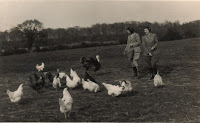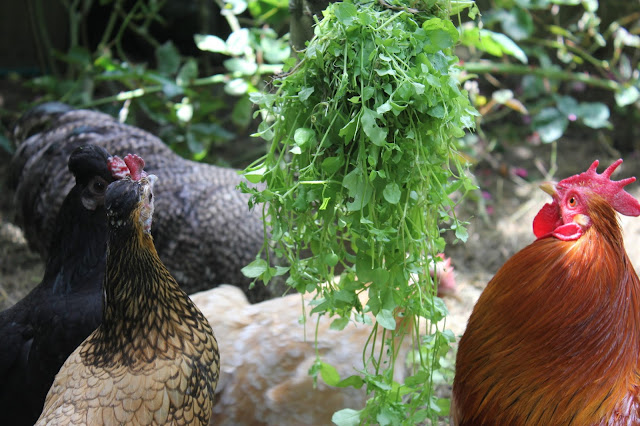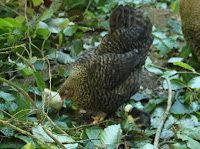It is not for nothing that one of the alternative names for stellaria media is 'The Hen's Inheritance'. The Greeks and Romans thought so highly of it they even cultivated it.
The Victorians coveted it as a super food and made it into all kinds of salads and sandwiches and chickweed is now enjoying a renaissance as a wild edible and herbal. You will easily find it everywhere, from seed catalogues to medical and beauty preparations.
Chances are you have no chickweed in your garden at the moment, if like me you have your birds free-ranging in your food forest, they will have eaten it. Why? Well because firstly it's often the only fresh weed available in the Winter months but also because of its valuable nutritional and medicinal value. Poultry, as I am often fond of writing, know more about their digestive systems and general health than we ever will.
Chances are you have no chickweed in your garden at the moment, if like me you have your birds free-ranging in your food forest, they will have eaten it. Why? Well because firstly it's often the only fresh weed available in the Winter months but also because of its valuable nutritional and medicinal value. Poultry, as I am often fond of writing, know more about their digestive systems and general health than we ever will.
So if you have a dearth of this ubiquitous plant, then why not do as we do and go and offer to weed someone else's organic garden or homestead. You will be earning their eternal gratitude and also gaining a forage plant that is worth all the gold in China.
In The Herball or Generall Hiftorie of Plantes, the 16th century botanist, herbalist and gardener, John Gerard wrote:
'Little birds in cages (efpecially Linnets) are refrefhed with
the leffer Chickeweed when they loath their meat : whereupon
it was called of fome Pafferina'
Chickweed
amongst its many virtues therefore, is a tonic and one my birds enjoy in the
Hungry Gap, which occurs, well about now! As with all good things however
there are certain provisos, which should be observed and considered and
I'll look at them too in the following paragraphs.
Chickweed Habits and Habitat
 Like poppies, witness this beautiful wheat field beyond our house, chickweed prefers soil that is periodically disturbed, such as that used for home vegetable cultivation or arable farmland. It grows in various soils but does particularly well in the damp earth shaded by overhead crops – hence in my neighbours' cabbages.
Chickweed reproduces by seed and can take less than 6 weeks to complete a growth cycle. Thus, although an annual, because of its ability to flower in all months, it can keep germinating and reseeding throughout the year. It also reproduces asexually or vegitatively by means of rooting at stem nodes, thus forming a dense mat of foliage. The average seed per plant was noted by the agricultural
engineer, Lucian.Guyot in his 1962 book Semences et plantules des principales mauvaises herbes to be as many as 25,000. Furthermore, seeds have the ability to lay dormant and thus remain viable for 10 years, I have actually read 40! Chickweed is thus an incredibly successful plant or shall we say weed and is one of the most common found on arable land, where it is also an important dietary element for many farmland wild birds, such as partridges, linnets and sparrows. Chickweed also has the ability to grow at low temperatures and survive all but the hardest of frosts. As an addendum to this, the 18th century botanist, William Withering, in his book A Systematic Arrangement Of British Plants, (1776), wrote of what he described as 'the sleep of plants'. This is the ability of certain plants including chickweed to protect its tender shoots and flower buds by covering them at night with older, larger and thus more frost hardy leaves.
Like poppies, witness this beautiful wheat field beyond our house, chickweed prefers soil that is periodically disturbed, such as that used for home vegetable cultivation or arable farmland. It grows in various soils but does particularly well in the damp earth shaded by overhead crops – hence in my neighbours' cabbages.
Chickweed reproduces by seed and can take less than 6 weeks to complete a growth cycle. Thus, although an annual, because of its ability to flower in all months, it can keep germinating and reseeding throughout the year. It also reproduces asexually or vegitatively by means of rooting at stem nodes, thus forming a dense mat of foliage. The average seed per plant was noted by the agricultural
engineer, Lucian.Guyot in his 1962 book Semences et plantules des principales mauvaises herbes to be as many as 25,000. Furthermore, seeds have the ability to lay dormant and thus remain viable for 10 years, I have actually read 40! Chickweed is thus an incredibly successful plant or shall we say weed and is one of the most common found on arable land, where it is also an important dietary element for many farmland wild birds, such as partridges, linnets and sparrows. Chickweed also has the ability to grow at low temperatures and survive all but the hardest of frosts. As an addendum to this, the 18th century botanist, William Withering, in his book A Systematic Arrangement Of British Plants, (1776), wrote of what he described as 'the sleep of plants'. This is the ability of certain plants including chickweed to protect its tender shoots and flower buds by covering them at night with older, larger and thus more frost hardy leaves. Stellaria Media - Virtues
What's in a name? Well in this case quite a lot, because chickweed is high in potassium, essential for development and growth. Birds deficient in potassium will fail to grow and die within a few days of hatch. In their study of thirty one wild edibles, published in 1996, Bianco and Santamaria, of the University of Bari, found that stellaria media had the second highest value of potassium. Given that Sir Humphrey Davy first identified potassium as an element in 1807, it is
interesting that, as with other vitamins and minerals found in forage,
the practical observation of how birds fed if not the why, was known many
centuries before. It is also probably why Mummy told them to eat up their greens....
 What is also very interesting from a human dietary point of view is that
'weeds', which were eaten as the precursors of the modern cultivated vegetable, (in fact most root vegetables were considered by the nobility as fit only for animals),
are often more nutritious and also obviously much easier to
grow!
What is also very interesting from a human dietary point of view is that
'weeds', which were eaten as the precursors of the modern cultivated vegetable, (in fact most root vegetables were considered by the nobility as fit only for animals),
are often more nutritious and also obviously much easier to
grow!
There is now a rekindled interest in wild edibles and I have seen various and differing nutritional contents for chickweed but I have sifted through and compared many research papers and articles and come up with what I hope and believe to be the most likely.
 What is also very interesting from a human dietary point of view is that
'weeds', which were eaten as the precursors of the modern cultivated vegetable, (in fact most root vegetables were considered by the nobility as fit only for animals),
are often more nutritious and also obviously much easier to
grow!
What is also very interesting from a human dietary point of view is that
'weeds', which were eaten as the precursors of the modern cultivated vegetable, (in fact most root vegetables were considered by the nobility as fit only for animals),
are often more nutritious and also obviously much easier to
grow!There is now a rekindled interest in wild edibles and I have seen various and differing nutritional contents for chickweed but I have sifted through and compared many research papers and articles and come up with what I hope and believe to be the most likely.
Ascorbic Acid –
Vitamin C
Beta-carotenes –
Vitamin A precursorsB Vitamins - notably Thiamine B1, Riboflavin B2, Niacin B3 and Folate B9
Bioflavonoids including rutin
Coumarins
Gamma-linolenic acid (omega-6 essential fatty acid)
Genistein
Minerals – including Calcium, Copper, Magnesium, Potassium, Iron, Manganese, Silicon and Zinc
Triterpenoid SaponinsPhenolic Acids
Cyclic peptides
Proteins
It is therefore no wonder, looking at this list, that this weed is now being trialled for a variety of pharmaceutical products including those for prevention and cure of Hepatitis b, cancers and heart disease.
Nitrate Accumulation and Oxalic Acid
This is one of the things that always impresses me with my chickens, they don't over-eat any single food item and they also eat 'the best bits' of everything. Leave apples for them in the garden and they will eat the pips first and then hollow out the fruit, leaving the skin, which contains most of the anti-nutrient phytic acid. When I used to give my poultry mixed dried grain, I always noted that they always consumed them in the same particular order. When I decided to reduce grain to the minimum and also only feeding it once sprouted, I chose the first grain they ate, triticale.
As discussed in an earlier post; Providing Forage for Organic Poultry Part 2 (link below), it is the dose that makes the poison. However, as with all forage, I am ever cautious when harvesting it in volume, as I do on occasions from my neighbours. They are organic gardeners but heavy on the manure due to sandy soil, I choose to harvest from amongst the cabbages, themselves hungry and competitive feeders for nitrate. As with all food that you introduce to your birds, be aware, if you are, for example, rehoming battery hens, that they may overdose on greenery. For all they know this is the one and only time you plan to feed them the essential nutrients they have been craving. Oxalic acid alters the uptake of calcium, so it is not something you want your laying hens, or young chicks to be gorging themselves upon. Stellaria media was measured by Bianco and Santamaria to contain 578mg per 100g which puts it slightly below spinach, which my birds will only eat in tiny amounts. The main thing is to put all forage out in an obvious form, I suspend it from bunches in the garden or put it on the ground. I would never think of chopping it up and putting it in their grated vegetables, for example. It is also an idea to put a mixed bouquet of weeds in, if you are feeding them on a regular basis.
Now if you'd like to sit back and watch the film. In it I also use the expectorant and demulcent virtues of chickweed to help with Rupert's head-cold.
If you have enjoyed this blog and found it interesting then please think about subscribing, sharing it and/or commenting. Please also feel free to ask questions.
All the very best,
RELATED POSTS
 Providing Forage for Organic Poultry Part 1
Providing Forage for Organic Poultry Part 1
Learning from the past. If you are setting up a forest garden to run your poultry
through it, you are probably going to be short of certain wild pasture elements...read more
Providing Forage for Organic Poultry Part 2
Continuing an in-depth look into forage and discussing the what, when, where from and why...read more
 Food for Free. Fabulous Forage Part 1 Grass
Food for Free. Fabulous Forage Part 1 Grass
For centuries farmers and homesteaders raised poultry on a forage-based
diet supplemented only by a handful of grain and the occasional table
scraps..read moreFood for Free. Fabulous Forage Part 3 Tree Fodder & Tree Hay
The idea of tree fodder is inextricably linked with the changing landscape, the full domestication of animals, the concept of farming and the clearance of the forests... read more
Food for Free. Fabulous Forage Part 4 Roses for Food & Forest
For me the rose is the quintessential forest garden plant, from canopy to ground cover there are so many to choose from ... read moreFood for Free. Fabulous Forage Part 5 Rose Petals
One of the main roses I use for both cooking, medicinals and which my hens very much enjoy is, not surprisingly, rosa gallica Officinalis, or The Apothecary Rose... read moreInteresting Reads:
Gerard, J. The Herball or Generall Hiftorie of Plantes. (1597)
Withering, W. A Botanical Arrangement of British Plants: Including the Uses of Each Species, in Medicine, Diet, Rural Economy and the Arts. (1787)
RETURN TO CONTENTS PAGE
© Sue Cross 2016









